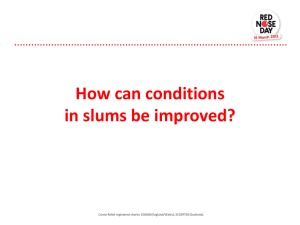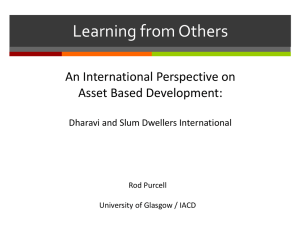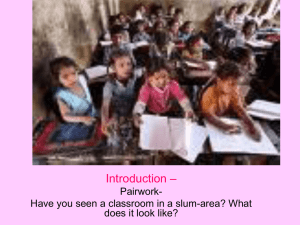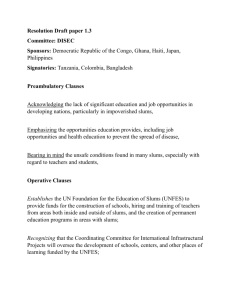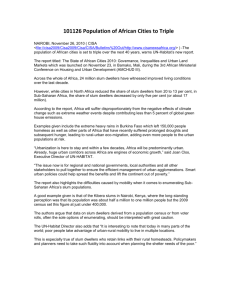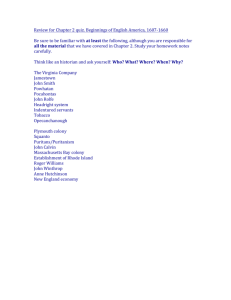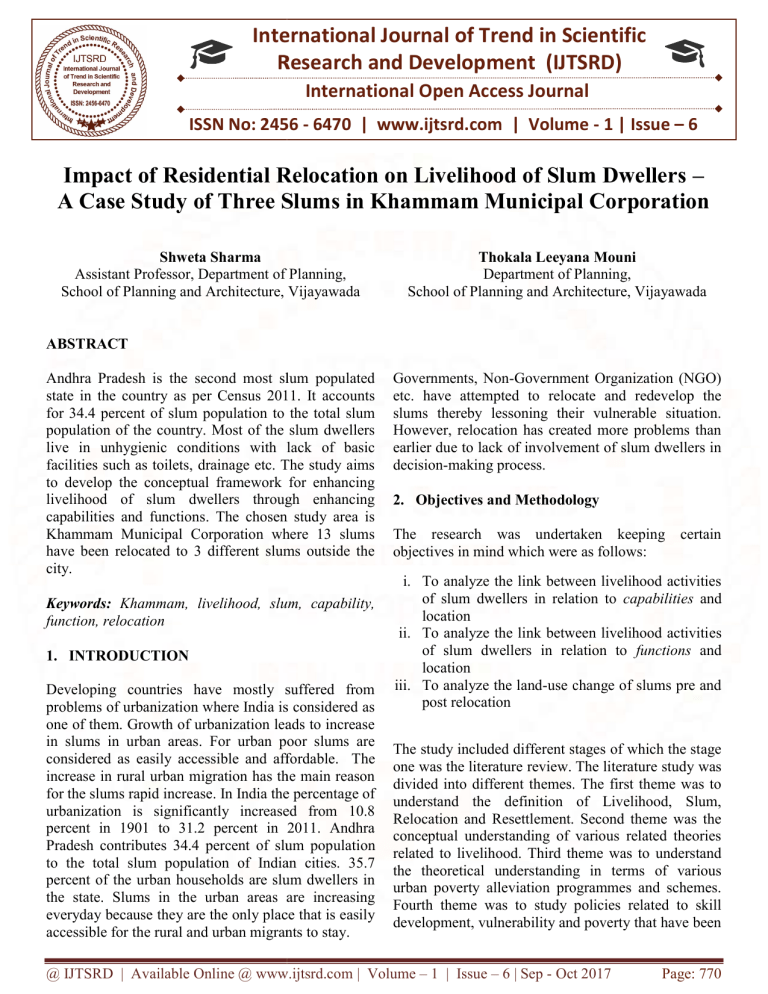
International Journal of Trend in Scientific
Research and Development (IJTSRD)
International Open Access Journal
ISSN No: 2456 - 6470 | www.ijtsrd.com | Volume - 1 | Issue – 6
Impact of Residential Relocation on Livelihood of Slum Dwellers –
A Case Study of Three Slums in Khammam Municipal Corporation
Shweta Sharma
Assistant Professor, Department of Planning,
School of Planning and Architecture, Vijayawada
Thokala Leeyana Mouni
Department of Planning,
School of Planning and Architecture, Vijayawada
ABSTRACT
Andhra Pradesh is the second most slum populated
state in the country as per Census 2011. It accounts
for 34.4 percent
ent of slum population to the total slum
population of the country. Most of the slum dwellers
live in unhygienic conditions with lack of basic
facilities such as toilets, drainage etc. The study aims
to develop the conceptual framework for enhancing
livelihood
hood of slum dwellers through enhancing
capabilities and functions. The chosen study area is
Khammam Municipal Corporation where 13 slums
have been relocated to 3 different slums outside the
city.
Keywords: Khammam, livelihood, slum, capability,
function, relocation
1. INTRODUCTION
Developing countries have mostly suffered from
problems of urbanization where India is considered as
one of them. Growth of urbanization leads to increase
in slums in urban areas. For urban poor slums are
considered as easily accessible and affordable. T
The
increase in rural urban migration has the main reason
for the slums rapid increase. In India the percentage of
urbanization is significantly increased from 10.8
percent in 1901 to 31.2 percent in 2011. Andhra
Pradesh contributes 34.4 percent of slum pop
population
to the total slum population of Indian cities. 35.7
percent of the urban households are slum dwellers in
the state. Slums in the urban areas are increasing
everyday because they are the only place that is easily
accessible for thee rural and urban migrants to stay.
Governments, Non-Government
Government Organization (NGO)
etc. have attempted to relocate and redevelop the
slums thereby lessoning their vulnerable situation.
However, relocation has created more problems than
earlier due to lack of involvement of slum dwellers in
decision-making process.
2. Objectives and
nd Methodology
The research was undertaken keeping certain
objectives in mind which were as follows:
follows
i. To analyze the link between livelihood activities
of slum dwellers in relation to capabilities and
location
ii. To analyze the link between livelihood activities
activiti
of slum dwellers in relation to functions and
location
iii. To analyze the land-use
use change of slums pre and
post relocation
The study included different stages of which the stage
one was the literature review. The literature study was
divided into different themes. The first theme was to
understand the definition of Livelihood, Slum,
Relocation and Resettlement. Second theme was the
conceptual understanding of various related theories
related to livelihood.. Third theme was to understand
the theoretical understanding
tanding in terms of various
urban poverty alleviation programmes and schemes.
Fourth theme was to study policies related to skill
development, vulnerability and poverty that have been
@ IJTSRD | Available Online @ www.ijtsrd.com | Volume – 1 | Issue – 6 | Sep - Oct 2017
Page: 770
International Journal of Trend in Scientific Research and Development (IJTSRD) ISSN: 2456-6470
adopted in India. Finally, fifth theme was case study
specific where different case studies were refereed to
understand the situation before going to field visit.
After the literature review was carried out from five
different themes, the parameters were identified.
Based on the parameters the questionnaire was
prepared and data was collected from both primary
and secondary sources at the time of field visit.
3. Study area: Khammam
Khammam has been chosen as the care to conduct this
research. It was a deliberate decision to choose
Khammam as already of couple of studies have been
done on metropolitan areas with population more than
100,000 areas but not in urban centers with population
between 100,000 to 999,999. Khammam city is in
Khammam District of Telangana state and, it is the
headquarters of the district. The City is located on the
banks of a river called Munneru, which is a tributary
of the Krishna River. In 2012 it was announced as a
Municipal Corporation. The municipal corporation is
spread over 93 sq. km. with a population of 3,56,000.
The population of the city is increasing manifold due
to constant migration of people from rural areas who
do not get housing in the city and thus contribute to
the slum population. Around 28.82 percent of people
reside in slum’s i.e. 72,664. There are 71 slums
(notified 28 and non notified 43) in Khammam
municipality. When Khammam was declared as
Municipal Corporation in 2012, the municipal
corporation chose 13 slums to be relocated to three
different slums in sub-urban areas (Figure 1) namely
Indiramma Colony, Y.S.R Colony and K.C.R Colony
(figure 2).
4. Data
The collected data can be divided into two types:
primary data and secondary data. Primary data was
collected by through primary survey. Secondary data
is second hand data that was collected by some other
surveyor for some other (or for his own) purpose.
Several methods were used to carry out primary
survey that includes survey through questionnaire,
focus group discussion and personal interview.
Questions were framed based on exiting literature.
The parameters to prove the hypothesis have been
derived from the Capabilities approach given by
Amartya Sen. Individuals differ greatly in their
abilities to convert the same resources into valuable
functionings (‘beings’ and ‘doings’). To realize those
functionings (such as their genuine opportunities to be
educated, their ability to move around or to enjoy
supportive social relationships) what is required are
capabilities in terms of subjective things (such as
happiness, satisfactory levels etc.) and on material
means to well being (such as resources like income or
wealth). Capabilities in this research have been
studied through skills, knowledge acquired by slum
dwellers and multiple jobs available to them,
proximity to school and proximity to hospital. The
associated functionings to the capabilities have been
measured through proximity and availability of jobs,
proximity and availability of multiple opportunities,
attending school and access to hospital.
Type of sampling considered for primary survey was
Simple Random Sampling method in the study area.
Cochran sampling technique, 1977 has been used to
calculate sample size:
X=
2
t * P(1-P)
ME
2
Where,
X= number of samples,
t= Appropriate Value from the normal distribution for
the desired confidence 95% i.e., 1.96,
P= Anticipated prevalence (Total population in one
slum/ total slum population in Khammam
Municipal Corporation),
ME2 = Marginal error (5% margin of error i.e., 0.05)
The household survey, focus group discussion and
face-to-face interview were conducted in the study
area to collect the data relating to livelihood,
capabilities and functions before and after relocation
of slums.
5. Analysis and discussion
5.1 Socio-Economic Profile
There are more females than males in the slum, the
distribution of gender is equal in KCR Colony and
males are more than females in case of YSR Colony.
In terms of education, more than 60% of the people
are uneducated in Indiramma Colony KCR Colony,
however less than 50% of people are uneducated in
YSR Colony. The occupational suggests that while
most of the men are engaged as auto drivers in
Indramma Colony and YSR Colony, and females are
housewives, KCR Colony on the other hand has a
predominance of men engaged in construction
activities and women being primarily housewives.
@ IJTSRD | Available Online @ www.ijtsrd.com | Volume – 1 | Issue – 6 | Sep - Oct 2017
Page: 771
International Journal of Trend in Scientific Research and Development (IJTSRD) ISSN: 2456-6470
5.2 Comparative profile of slums pre and post
relocation
5.2.1 Income Levels
The income levels have decreased post relocation of
slums in all the three slums. More people have come
within the income bracket of ₹ 1000-₹ 3000 per
month, which happens to be the lowest income
bracket.
Cost of travel:
Similarly cost of travel to work, school and hospitals
increased substantially post relocation. In case of
travel to work and school, the costs have doubled for
an average being spent as ₹ 20 per day pre-relocation
to ₹ 60 per day being spent post relocation. With
regard to medical facilities, the travel cost has gone
beyond ₹ 100 per visit, while it was ₹ 40 per month
on average pre relocation.
5.2.2 Distance to work:
The increasing cost of travel is a direct result of
increased distance to schools, hospitals and places of
work. The average distance to work for the males has
increased from 2-5 Km pre-relocation to more than 8
Km post relocation. For females, distance to work has
decreased from 7-8 Km to 5-6 Km because they used
to work as agricultural labors earlier but need to go to
far off places now to work as maids (figure 3,4).
5.2.3 Distance to hospital and school
Proximity to hospital and schools is considered as
capability. Distance to facilities has increased per trip
and cost per trip has also increased which are
considered as functions. Because of the increase in
distance and cost of travel to schools and hospitals
(Figure 5,6,7,8), functions to school and hospitals
decreased. According to URDPFI guidelines, distance
of facilities to residential location of slum dwellers is
should be maximum 4Km for Hospital and 0.5-1Km
for schools. Before relocation facilities were
accessible as per standards, however, after relocation
facilities are not in proximity. Proximity to school and
hospitals is important because it will help in
increasing the capabilities, which will lead to
functions, as a result this will lead to better livelihood
prospects.
5.3 Regression Analysis
A regression analysis was done to ascertain how the
parameters are related to income in case of the three
slums. The formula for regression was as follows:
Income = intercept + coefficient * dtw + coefficient
* ctw + coefficient * ds + coefficient * cts
+ coefficient * dh + coefficient * cth
where:
ctw = cost of distance to work;
cts = cost of travel to school;
cth = cost of distance to hospital
Here income is the dependent variable and remaining
all parameters are independent variables affecting
income.
5.3.1 Regression: Indiramma Colony
The regression equation for Indiramma colony is as
follows:
Income = 2.94 - 0.02 ctw - 0.08 cts - 0.07 cth
The equation reveals a major impact of cost of travel
to school on the income levels of residents in
Indiramma colony. Pre-relocation, 69% of slum
dwellers were spending no money on sending their
children to schools as the schools were within walking
range of 0.5-1 km. However, post relocation the
distance to school increased to 5kms and thus 86%
people are spending ₹ 40-50 per day to send their
children to school. The interesting thing is the cost of
travel to work does not have a strong bearing on
income, as the residents have been able to find work
opportunities near to their residential location postrelocation.
5.3.2 Regression: KCR Colony
The regression equation for KCR colony is as follows:
Income = 6.45 - 0.23 ctw - 0.23 cts - 0.41 cth
As per the regression analysis, the cost of travel to
hospital has increased substantially and it has a major
bearing on the income levels of residents in KCR
Colony. While pre-relocation, 60% of slum dwellers
used to spend between ₹40-50 per visit to the hospital,
however, post-relocation the cost of travel per visit to
the hospital increased to more than ₹ 100.
5.3.3 Regression: YSR Colony
The regression equation for KCR colony is as follows:
Income = 11.24 - 0.32 ctw - 0.08 cts - 0.14 cth
The cost of travel to work has a major impact on the
income levels of residents of YSR colony. While the
@ IJTSRD | Available Online @ www.ijtsrd.com | Volume – 1 | Issue – 6 | Sep - Oct 2017
Page: 772
International Journal of Trend in Scientific Research and Development (IJTSRD) ISSN: 2456-6470
average cost of travel to work of the 13 re-located
slums was ₹ 20 per day, the cost of travel has risen to
₹ 40-50 for 60% of the residents of YSR colony.
Similarly, cost of travel to hospital per visit has risen
from ₹ 40 to ₹ 100 on average post relocation.
dwellers will decrease and will lead to provision of a
single job or no job. It was observed that postrelocation, the land use composition was low (table
1). Hence the relocation was negatively impacting the
livelihood of slum dwellers.
5.4 Land Use Matrix
The land use matrix analysis reveals the major land
uses, pre and post relocation, in the 1.25 meter buffer.
This 1.25 meter buffer is based on the average work
distance proposed by the RAY scheme in India (figure
9,10). A variety of land uses provide multiple
livelihood opportunities for residents. If land use
composition is poor, then opportunities for slum
5.5 Cause and effect analysis
The officials in Khammam Municipal Corporation are
following top down approach without considering
people’s viewpoint while relocating the slums.
Table 1: Land-use matrix
Slum Name
Residen
tial
Commer
cial
Industri
al
Publi
c/se
mi
publi
c
Gree
n
cover
Agri
cultu
ral
Fore
st
land
Sweepers Colony
Yes
Yes
No
Yes
No
No
No
Pakabanda Dhobhiwada
Yes
Yes
No
Yes
Yes
No
No
Shukravaripeta
Yes
Yes
Yes
Yes
Yes
No
No
Nizampet
Yes
Yes
No
Yes
Yes
No
No
Ricob Bazar
Yes
Yes
No
Yes
No
No
Parsibandam
Yes
No
No
Yes
Yes
No
No
Sambhani Nagar
Yes
No
No
Yes
Yes
No
No
Srinivas Nagar
Yes
No
Yes
Yes
Yes
No
No
Labadi Thanda
Yes
Yes
Yes
Yes
Yes
No
No
sharada nagar
Yes
Yes
No
Yes
Yes
No
No
Ramana Gutta
Yes
Yes
No
Yes
Yes
No
No
S.T. Colony
Yes
Yes
Yes
Yes
Yes
No
No
S.C. Colony
Yes
Yes
Yes
Yes
Yes
No
No
Indiramma Colony
Yes
No
No
No
No
Yes
Yes
Y.S.R Colony
Yes
No
No
No
No
Yes
Yes
K.C.R Colony
Yes
No
No
No
No
Yes
Yes
@ IJTSRD | Available Online @ www.ijtsrd.com | Volume – 1 | Issue – 6 | Sep - Oct 2017
Page: 773
International Journal of Trend in Scientific Research and Development (IJTSRD) ISSN: 2456-6470
2456
The rural people are migrating from rural to urban
areas, in search of better livelihood. This is
leading to rapid increase of slums in urban areas.
As a result, relocation of slums is happening in
urban areas, which is affecting
ffecting their capabilities
and functions and finally impacting their
livelihood negatively. The cause and effect of this
cyclical proves is explained in figure 111. The
major issues in the relocation process done for
slums in Khammam city are that the lland from
where the slums have been relocated is being used
for commercialization
mercialization instead of using for low
income housing, the
he new land has not benefitted
the poor, current
urrent framework does
do not respond to
economic issues, capabilities
apabilities (opportunities) and
functions (performing opportunities) have
decreased and the residents of the three relocated
colonies have not received any payment as
promised by government officials (table 2).
Table 2: Average income and expenditure per month
Relocated
colony
name
Reloc
ation
status
Income
(Rs.)
Cost of
travel
to work
(Rs.)
%
Indiramma
colony
2.K.C.R
Colony
3. Y.S.R
Colony
Pre
Post
Pre
Post
Pre
Post
5319.6
4523.5
7251.5
6964
8659.1
7859.1
134
1368
729
1774.8
453
1698
2.5
30.24
10.05
25.48
5.23
21.6
Cost of
travel
to
school
(Rs.)
170
664.56
360
601.9
258
731.64
%
Cost of
travel to
hospital
(Rs.)
%
Total
Cost of
travel
%
3.19
14.69
4.96
8.64
2.97
9.30
38.86
80
34.75
99
40.91
100
0.73
1.76
0.47
1.42
0.47
1.27
6.42
46.69
15.48
35.54
8.67
32.17
6. Conclusion
In Khammam City,, the relocation of slums did not
happen according to standards. 13 slums were
relocated to three different areas, which are all in the
peripheral areas of the city. The various analysis
conducted during the research revealed that the
relocation
ocation is negatively impacting capabilities and
functions, which negatively impacts the livelihood of
the slum dwellers.
This is perhaps due to the top-down
down approach
followed by Municipal Corporation dur
during relocation.
The people migrated to cities for better livelihood but
again they were relocated to sub-urban
urban areas that are
vulnerable in terms of provision of various facilities
and opportunities for the residents of the relocated
colonies. Thus it is strongly recommend
ecommended that the
future relocation exercises for slums in urban areas
should be essentially bottom-up
up where all the bodies
and agencies (government and non- government) and
private sector should coordinate and give the
proposals based on the survey
rvey and view points
point of
people to build a better society. Due to time
constraints, the study was only limited to the slums
relocated over the last two years. However, if a
similar research would be conducted for slums
relocated for a longer duration, then it would generate
interesting results. Also, as a matter of convenience,
only notified slums were considered for research.
However, future research can also concentrate on nonnon
notified slums as well. This research paves a way for
future work to be done in context of understanding
impact on capabilities and functions of slum dwellers
rather than simply looking at their income and
expenditure patterns in the process of relocation.
References
1) Abu-Salia
Salia R, Kanton Osumanu I and Abubakari
Ahmed. (2015). Coping with the Challenges of
Urbanization in Low Income Areas: An Analysis
of the Livelihood Systems of Slum Dwellers of the
@ IJTSRD | Available Online @ www.ijtsrd.com | Volume – 1 | Issue – 6 | Sep - Oct 2017
Page: 774
International Journal of Trend in Scientific Research and Development (IJTSRD) ISSN: 2456-6470
Wa Municipality, Ghana. Ghana: Scientific
research publishing.
2) Alamgir M. S, Jabbar M. A and Islam M. S.
(2009) Assessing the livelihood of slum dwellers
in Dhaka city, Journal of Bangladesh Agriculture
University. 7(2): pp. 373 -380.
3) Beall J and Nazneen Kanji1, (March 1999)
Households, livelihoods and urban poverty.
Department of Social Policy and Administration
London School of Economics and Political
Science. London.
4) Chambers, C. (1992). The Sustainable Livelihood
Approach to Poverty Reduction. Swedish
international development cooperation agency.
Sweden: Sida.
5) Chattopadhyay.S, Biswas.A. (2010). Slum
improvement through legal framework in India,
International Journal for Housing Science,
Vol.34, No.2 pp. 139-150.
6) Government of India. (2013). Best Practices:
Habitat Planning & Design for the Urban Poor.
Delhi: Ministry of Housing & Urban Poverty
Alleviation.
7) Government of India. (2013). National Urban
Livelihood Mission. Delhi: Ministry of Housing &
Urban Poverty Alleviation.
9) Government of India. (2013). State of slums in
India: A statistical compendium. Delhi: Ministry
of housing and urban poverty alleviation, National
building organisation.
10) Johannesburg, J. (2014). Forced relocation from
informal settlements to the periphery and effects
on livelihoods: A case of Diepsloot, South Africa.
International Journal of Urban and Regional
Research, Vol. 27(3), pp. 591-612.
11) Patil, R. 2012. The Civic Facilities: A Study of
Resettlement in Kagal Taluka of Kolhapur
District. Golden Research Thoughts, Vol. 1 (IX)
pp. 1-4.
12) Sen, A. (1981). Poverty and Famines - As Essay
on Entitlement and Deprivation. Oxford:
Clarendon press.
13) Uancharoenkul P (2009) A Slum Upgrading
Framework Taking Opportunity Cost into
Account: A case study of Thailand. Dept. of Real
Estate and Construction Management Master of
Science, Thesis no. 466, Div. of Building and Real
Estate Economics. Thailand.
14) UK Department for International Development.
(1997). Sustainable Livelihoods Guidance.
Department for international development. United
Kingdom
8) Government of India. (2011). Rajiv Awas Yojana.
Delhi: Ministry of Housing & Urban Poverty
Alleviation.
@ IJTSRD | Available Online @ www.ijtsrd.com | Volume – 1 | Issue – 6 | Sep - Oct 2017
Page: 775
International Journal of Trend in Scientific Research and Development (IJTSRD) ISSN: 2456-6470
2456
Figure 1: Slum Map of khammam
Figure 2: Three relocated slums
@ IJTSRD | Available Online @ www.ijtsrd.com | Volume – 1 | Issue – 6 | Sep - Oct 2017
Page: 776
International Journal of Trend in Scientific Research and Development (IJTSRD) ISSN: 2456-6470
Figure 3: Distance to work pre-relocation
Figure 4: Distance to work post-relocation
@ IJTSRD | Available Online @ www.ijtsrd.com | Volume – 1 | Issue – 6 | Sep - Oct 2017
Page: 777
International Journal of Trend in Scientific Research and Development (IJTSRD) ISSN: 2456-6470
Figure 5: Distance to hospital pre-relocation
Figure 6: Distance to hospital post-relocation
@ IJTSRD | Available Online @ www.ijtsrd.com | Volume – 1 | Issue – 6 | Sep - Oct 2017
Page: 778
International Journal of Trend in Scientific Research and Development (IJTSRD) ISSN: 2456-6470
Figure 7: Distance to schools pre-relocation
Figure 8: Distance to schools post-relocation
@ IJTSRD | Available Online @ www.ijtsrd.com | Volume – 1 | Issue – 6 | Sep - Oct 2017
Page: 779
International Journal of Trend in Scientific Research and Development (IJTSRD) ISSN: 2456-6470
Figure 9: Land Use pre-relocation
Sharada
Nagar
RicobBazar
Sweepers
Colony
RamanaGutta
Nizampeta
S.C Colony
3
2
S.T Colony
Shukravaripe
ta
1
Lambadi
Thanda
Srinivas
Nagar
Sambhani
Nagar
Parsibandam
PakabandaD
hobhiwada
Figure 10: Land Use post-relocation
1) Indiramma
Colony
2) Y.S.R Colony
3) K.C.R
Colony
@ IJTSRD | Available Online @ www.ijtsrd.com | Volume – 1 | Issue – 6 | Sep - Oct 2017
Page: 780
International Journal of Trend in Scientific Research and Development (IJTSRD) ISSN: 2456-6470
Figure 11: Cause and effect analysis
Ca
use
Rural area- Lack of
opportunities
Significant increase in
slums and slum
population
Resettlement and relocation
again in Rural areas
Lack of multiple options,
capabilities and functions
Cause and Effect Flow-Chart
Eff
ect
Migration to urban
areas
Relocation,
Resettlement &
rehabilitation by
government officials
Lack of proper
housing,
infrastructure
facilities
Decrease in
employment
opportunities
Increase in distance
Decrease in income
levels and increases in
expenditure on
transportation
@ IJTSRD | Available Online @ www.ijtsrd.com | Volume – 1 | Issue – 6 | Sep - Oct 2017
Page: 781

